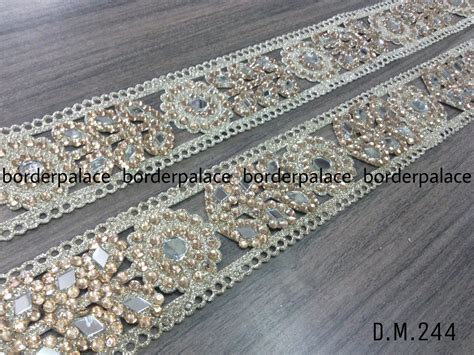Lace, an intricate fabric made from fine threads or yarns, has been a symbol of elegance, sophistication, and craftsmanship for centuries. India, with its rich textile heritage, is a prominent global player in the lace industry, renowned for producing high-quality, exquisite lace products.

Industry Overview
The Indian lace industry is estimated to be worth over USD 2 billion, catering to both domestic and international markets. The country is home to numerous lace manufacturers, ranging from small-scale artisans to large-scale industrial units.
Top 10 Lace Manufacturers in India
| Rank | Manufacturer | Established | Locations |
|---|---|---|---|
| 1 | P.A. Lace & Netting Co. Ltd. | 1964 | Mumbai, Surat |
| 2 | Mahalaxmi Lace Industries | 1972 | Surat |
| 3 | Krishna Lace & Netting Industries | 1986 | Surat |
| 4 | Raj Lace & Netting Co. | 1990 | Surat |
| 5 | Virani Embroidery Lace Private Limited | 1995 | Surat |
| 6 | Rada Lace & Netting | 1998 | Surat |
| 7 | Indo Lace & Netting | 2000 | Surat |
| 8 | Asmita Lace & Netting | 2005 | Surat |
| 9 | Jayshree Lace & Netting | 2010 | Surat |
| 10 | Golden Era Lace & Netting | 2015 | Surat |
Types of Lace
Indian lace manufacturers produce a wide variety of lace types, including:
- Bobbin lace: Made by twisting and knotting thread on bobbins.
- Needlepoint lace: Created using a needle and thread to create intricate designs.
- Crochet lace: Hooked with a fine hook to create openwork patterns.
- Machine lace: Produced using specialized machines to create complex designs.
Applications
Lace finds application in a diverse range of products and industries, including:
- Textiles and Apparel: Adorning garments, lingerie, home decor, and accessories.
- Fashion and Design: As embellishments for high-end fashion, jewelry, and footwear.
- Home Decor: Enhance curtains, upholstery, table linen, and wallpapers.
- Accessories: Adding intricate details to handbags, scarves, and belts.
- Industrial Applications: Filtration, medical supplies, and packaging.
Why Choose Indian Lace?
- Quality: Indian lace is known for its exceptional quality and durability.
- Variety: Available in a vast array of designs, materials, and colors.
- Cost-Effectiveness: India offers competitive manufacturing costs, making high-quality lace accessible.
- Sustainability: Many Indian lace manufacturers adhere to ethical and sustainable practices.
- Innovation: Indian lace manufacturers are constantly developing new and innovative lace designs.
Tips and Tricks
- Consider the fabric: Choose lace that complements the texture and drape of the fabric it will be applied to.
- Accessorize sparingly: Use lace as an accent piece to avoid overwhelming the garment or accessory.
- Maintain and care: Avoid harsh chemicals and follow care instructions to preserve the lace.
- Experiment with different colors: Explore a range of colors to complement the overall design.
- Accessorize with confidence: Embrace the beauty of lace and use it to elevate any outfit or item.
Common Mistakes to Avoid
- Overuse of lace: Avoid excessive use of lace, as it can create a disjointed or cluttered look.
- Unflattering silhouettes: Choose lace designs that flatter your body shape and create a cohesive silhouette.
- Poor quality: Opt for high-quality lace from reputable manufacturers to ensure durability and aesthetics.
- Incorrect care: Avoid improper washing and drying methods that can damage the lace.
- Limitations in design: Explore lace’s versatility and open yourself to unconventional applications.
The Future of Lace
Lace is an evergreen fabric that continues to evolve with changing fashion trends and consumer preferences. Indian lace manufacturers are poised to drive this evolution, experimenting with new materials, designs, and applications. One innovative application is “LaceTech,” where lace is integrated into electronic devices to create wearable technology with enhanced functionality and aesthetics.
Tables
Table 1: Types of Lace by Manufacturing Technique
| Technique | Characteristics |
|---|---|
| Bobbin Lace | Intricate and delicate, often handcrafted |
| Needlepoint Lace | Precise and detailed designs, requires specialized skills |
| Crochet Lace | Openwork patterns created with a hook |
| Machine Lace | Complex designs produced using specialized machinery |
Table 2: Applications of Lace in Different Industries
| Industry | Applications |
|---|---|
| Textiles and Apparel | Embellishments for garments, lingerie, accessories |
| Fashion and Design | High-end embellishments for clothing, jewelry, footwear |
| Home Decor | Curtains, upholstery, table linen, wallpapers |
| Accessories | Handbags, scarves, belts |
| Industrial Applications | Filtration, medical supplies, packaging |
Table 3: Benefits of Choosing Indian Lace
| Benefit | Value |
|---|---|
| Quality | Exceptional quality and durability |
| Variety | Vast range of designs, materials, and colors |
| Cost-Effectiveness | Competitive manufacturing costs |
| Sustainability | Endorsement of ethical and sustainable practices |
| Innovation | Constant development of new and innovative lace designs |
Table 4: Common Mistakes to Avoid When Using Lace
| Mistake | Consequence |
|---|---|
| Overuse of Lace | Disjointed or cluttered look |
| Unflattering Silhouettes | Unattractive or unflattering appearance |
| Poor Quality | Lack of durability, aesthetic compromise |
| Incorrect Care | Damage or deterioration of lace |
| Limitations in Design | Missed opportunities for creative applications |
